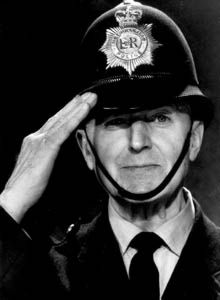

The police station featured in the opening titles was the previous Ealing police station, located at number 5 High Street, just north of Ealing Green.

The main character, Police Constable George Dixon, played by Jack Warner, was an old-style British "bobby" (Police Man). The character first appeared in a 1950 British film by Ealing, The Blue Lamp, in which he was shot and killed by a criminal played by Dirk Bogarde. However, it was decided to bring him back to life for a television series, written by Ted Willis. Designer was Laurence Broadhouse.
If Dixon was known to the public, the actor Jack Warner was even better known. Born in London in 1896, Warner had been a Comedian in radio and in his early film career. Starting in the early 1940s, he broadened his range to include dramatic roles, becoming a warmly human character actor in the process. But as well as playing in films with dramatic themes, such as The Blue Lamp, Warner continued to play in comedies such as the successful Huggett family programmes on BBC Radio and films made between 1948 and 1953.

In Dixon of Dock Green, Dixon is a "bobby" on the beat - lowest-ranking policeman on foot patrol. With the inevitable heart of gold, Dixon was a widower raising an only daughter Mary (Billie Whitelaw in early episodes, later replaced by Jeanette Hutchinson).
Subtitled in the early days: Some Stories of a London Policeman, each episode started with Dixon speaking to the camera. He began with a salute and the greeting "Good evening all", which was changed to "Evening all" in the early 1970s, which has lived on in Britain as a jocular greeting. In similar fashion, episodes finished with a few words to camera from Dixon in the form of philosophy on the evils of crime.
Initially, Dixon continued in the same role as in the film The Blue Lamp, a constable based at the fictitious Dock Green police station in the East End of London. The character of Andy Mitchell (played by Jimmy Hanley), the young constable in the film, became a detective named Andy Crawford (played by Peter Byrne), in the CID at Dock Green, and he was married to Dixon's 23 year old daughter, Mary (who did not appear in the film) in the 19th episode, Father in Law (1st Sept 1956). Dixon sings a few songs at the wedding and wishes the viewers goodbye at the end of the episode (this was the end of series 2 and series 3 was four months away). The couple moved to a flat in Chelmsford.

By the final years of the series in the 1970s, Warner was getting elderly and looking increasingly implausible even in a desk job (as he had increasing difficulty moving about, helped slightly by a treatment involving bee stings). In the final series, when Warner was 80, George Dixon was shown as retired from the police and being re-employed as a civilian collator.
In 2005, the series was revived for BBC radio, adapted by Sue Rodwell, with David Calder as George Dixon, David Tennant as Andy Crawford, and Charlie Brooks as Mary Dixon. A second series followed in 2006, with Hamish Clark replacing Tennant owing to the latter's Doctor Who recording commitments.

The BBC scheduled Dixon in the family time slot of 6:30 on Saturday night. At the time it started on air in 1955, the drama schedule of the BBC was mostly restricted to television plays so that Dixon of Dock Green had little trouble in building and maintaining a large and loyal audience. In 1961, the series was voted second most popular programme on British television with an estimated audience of 13.85 million. Even in 1965 after three years of the gritty and grimy procedural police-work of Z-Cars, the audience for Dixon stood at 11.5 million. However as the 1960s wore on, ratings began to fall and this, with health questions around Jack Warner, led the BBC to end the series in 1976.
The series was the creation of writer Ted Willis, who not only wrote the series over its 20 years on British television but had a controlling hand in production. Longtime producer of the series was Douglas Moodie whose other television credits include The Inch Man and The Airbase. Dixon was originally produced at the BBC's studios at Lime Grove. Altogether some 430 episodes were made, at first running 30 minutes and later 45 minutes.
In 1988, a screenplay called The Black and Blue Lamp was shown on BBC TV. In it two identical criminals named Tom Riley, one from the 1950 film (in which Dixon dies) and one from the 1980s, swap places in time. The one from the 80's experiences the soft policing of the Dixon TV series. Meanwhile, the one from 1950 experiences the very harsh policing of the 80's, represented by a parody of violent police procedurals called The Filth. There he discovers that the Dixon of the divergent Dock Green timeline, who has also just been killed, was as bad as any copper could be.
One of Dixon's closing monologues from Dixon of Dock Green was recycled for the final scene of Ashes to Ashes in 2010. Like The Black and Blue Lamp, characters in Ashes to Ashes and its predecessor, Life on Mars, were seemingly sent into different eras of policing. Moreover, Dixon's 'resurrection' for Dixon of Dock Green, after having been killed in The Blue Lamp, parallels the stories of the principal characters in Life on Mars and Ashes to Ashes, having been explained in the final episode.






